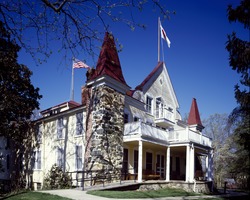


Clara Barton National Historic Site, U.S. National Register of Historic Places, U.S. National Historic Landmark,U.S. National Historic Site, Clara Barton's Home, Glen Echo, Maryland LCCN2011631520.tif, The Clara Barton House, Clara Barton National Historic Site is located in Maryland, Clara Barton National Historic Site, Location: 5801 Oxford Rd., Glen Echo, Maryland, Area 9 acres (3.6 ha), Built 1891, Architect Julian B. Hubbell, Added to NRHP October 15, 1966, Designated NHL January 12, 1965, Designated NHS 1974.
The Clara Barton National Historic Site, which includes the Clara Barton House, was established in 1974 to interpret the life of Clara Barton (1821-1912), an American pioneer teacher, nurse, and humanitarian who was the founder of the American Red Cross. The site is located 2 miles (3.2 km) northwest of Washington D.C. in Glen Echo, Maryland. This site is currently closed to the public.
The United States National Historic Site protects 9 acres (0.04 km²) of land at her Glen Echo home including the 38-room former residence of Barton. The site is managed by the George Washington Memorial Parkway. The first national historic site dedicated to the accomplishments of a woman, it preserves the early history of the American Red Cross and the last home of its founder. Clara Barton spent the last 15 years of her life in her Glen Echo home (1897-1912), and it served as an early headquarters of the American Red Cross as well.
The National Park Service has restored eleven rooms, including the Red Cross offices, parlors and Clara Barton's bedroom. Visitors to Clara Barton National Historic Site can gain a sense of how Barton lived and worked surrounded by all that went into her life's work. Visitors to the site are led through the three levels on a guided tour emphasizing Barton's use of her unusual home. In 2005, 12,529 visitors toured the site.
Description
The large frame house was partially constructed from lumber salvaged from emergency buildings built by the Red Cross at Johnstown, Pennsylvania in the wake of the Johnstown Flood of 1889. The lumber of the dismantled buildings was brought to Washington via the Chesapeake and Ohio Canal to avoid flooding the local market in Johnstown. The lumber was stored on a lot owned by Barton in Washington D.C. until early in 1891 when construction began on land donated by Edwin and Edward Baltzley, who were developing a Chautauqua assembly at Glen Echo. The house was designed by Dr. Julian B. Hubbell, the first field agent of the American Red Cross. Hubbell oversaw the construction work performed by Baltzley's construction team. The original structure included a massive stone front in a style in keeping with the rest of the Chautauqua buildings. In 1897, when Barton moved into the house permanently, the central part of the stone facade was dismantled, creating flanking stone towers. The addition of pointed roofs accentuated the effect on the deep, narrow house.
In spite of its massive size, the house is sparely detailed and furnished for utility. The interior is designed as if it were a Mississippi River steamboat. The house contains 36 rooms and 38 closets, with three tiers of rooms facing a central gallery lighted by clerestory windows of colored glass.
The Clara Barton House was designated a National Historic Landmark in 1965, and was listed on the National Register of Historic Places in 1966.
For More Information:
Clara Barton, Civil War Nurse, Humanitarian and Founder of the American Red Cross